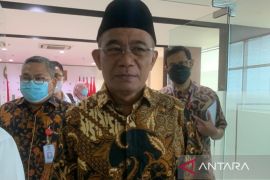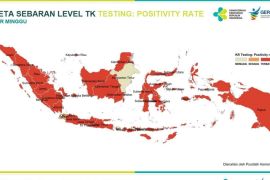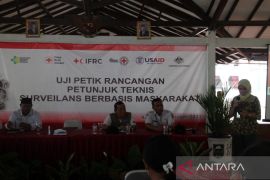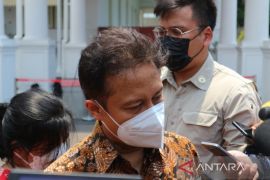"I think all health care subsystems must be transformed to increase their competitivenessJakarta (ANTARA) - At the G20 Summit in Rome in October 2021, President Joko Widodo (Jokowi) invited G20 leaders to partake in strengthening the global health architecture to build a world more resilient to pandemics and future shocks.
One of the efforts to strengthen the global health architecture is by developing global health resources encompassing funds, vaccines, medicines, medical devices, and health workers that can be deployed at any time to help a country facing a crisis.
However, before discussing global health resources, the Indonesian government should also oversee the situation of the country's health sector.
Several health problems faced by Indonesia necessitate equal distribution of health resources in various regions.
Director-General of Health Services at the Ministry of Health, Abdul Kadir, pointed out that Indonesia continued to be plagued by persistent health problems despite the government's funding for prevention getting bigger with each passing year.
From Rp490 trillion of Indonesia’s annual health spending, 52.1 percent was absorbed through the State-owned Healthcare and Social Security Agency (BPJS Kesehatan) and local governments' health services, while the absorption of funds from private and private health services had reached 47.9 percent.
Related news: Indonesian gov't must aim for 100% vaccination coverage: expert
Health problems afflicting Indonesia also continue to rise, including those arising from an increase in the life expectancy of Indonesians that causes changes in the population pyramid along with an increase in the number of elderly.
This is followed by the problem of stunting in children. Data shows that the stunting percentage in Indonesia reaches 28 percent for children under the age of five years.
Meanwhile, Indonesia ranks second in the world on account of the number of cases of Tuberculosis (TB) still being quite high. The number of deaths from non-infectious diseases, such as cancer, diabetes, heart disease, and stroke, is higher in Southeast Asia, with an average percentage of 60 per year.
The smoking population involving those in the age bracket of 15 years and above also occupies the highest prevalence among ASEAN countries.
“With more money being spent by our government, the health status of our people should actually increase,” Kadir pointed out.
Another problem faced by the Indonesian government is the lack of community health centers (Puskesmas) in 171 sub-districts across Indonesia due to the region's expansion.
Related news: 148.98 million Indonesians fully vaccinated against COVID-19
The government had, in fact, planned to build 67 Puskesmas in Papua. However, Kadir stated that the government's next challenge was to fulfill the human resources (HR) position in Puskesmas.
“Right now, we have Puskesmas with no doctor. Some 50 percent of the doctors are in Maluku and Papua. This problem is related to medical education,” he noted.
In this case, Kadir drew attention to the fact that Indonesia still lacks the number and distribution of medical human resources. With a medical graduate rate of 12 thousand per year, it will take a decade to meet the Asian equivalent ratio of doctors to the population.
Indonesia requires an average of about 0.67 doctors for every one thousand people, whereas the average for 20 Asian countries is 1.2 doctors per one thousand citizens, while for countries as members of the Organisation for Economic Co-operation and Development (OECD), the ratio is 3.2 doctors per one thousand citizens.
The Ministry of Health's data also shows behavioral tendencies of Indonesian people seeking treatment abroad. Around one million Indonesians seek treatment abroad and spend US$11.5 billion of the state money, or Rp165 trillion.
The ratio of beds to the total population in Indonesia was at 1.18, while in Asia, the average is 3.3. This means the opportunity to build a hospital in Indonesia is still very large.
However, Kadir noted that several hospitals in Indonesia were located in big cities. The availability of hospital beds in Maluku, Papua, and Kalimantan is still limited.
Related news: Indonesia mulls pandemic to endemic shift
Health transformation
Based on the various health problems in the country, Kadir suggested that health transformation should be conducted.
The role of the Indonesian Doctors Association (IDI) is important to achieve equitable distribution of health resources.
Chairman of the IDI Executive Board, Daeng M. Faqih, stated that transformation of the health sector in various fields was deemed necessary to improve health services in Indonesia.
The transformation also applies to doctors, who have a strategic position in medical services, both in terms of ability and literacy.
In addition, Faqih suggested a transformation in the field of health care financing, so that Indonesia will not lose its competitiveness at the global level.
The strengthening of Puskesmas, as the spearhead of health services, also should be intensified and be equipped with the latest technology to make it more optimal.
"I think all health care subsystems must be transformed to increase their competitiveness,” Fiqih remarked.
On the other hand, the Ministry of Health has also initiated six pillars of Indonesia's health transformation to overcome the problem, including restoring the function of Puskesmas as a community health service, with more promotive and preventive functions, and secondary health services by increasing education services and health screening to detect diseases early.
Related news: National Police chief rolls out booster vaccinations for workers
Furthermore, the required transformation aims to build several hospitals for handing and treatment of the four main diseases -- heart disease, stroke, cancer, and dialysis -- that mostly cause mortality in Indonesia.
The government prioritizes the target of establishing integrated cardiac services in 34 provinces by 2024, with the Ministry of Health giving priority to IDI by providing scholarships to address the doctor shortage in Indonesia.
In addition, the government is readying regulations to encourage the production of domestic medical devices that must be purchased and used by hospital managers. Imported products are still permitted if the producer builds the factory in Indonesia.
Regarding medical human resources, the Ministry of Health has prepared 1,000 scholarships in the medical field for students and high school graduates from remote areas, borders, and islands to address the dearth of medical personnel in Maluku and Papua. This includes encouraging the opening of more medical faculties and empowering the potential of Indonesian diaspora doctors.
Health services in future will no longer use manual tools but must be technology-based and develop biotechnology.
The government, through Government Regulation Number 47 of 2016 concerning Health Service Facilities and the Job Creation Act or Law Number 11 of 2020 concerning Job Creation, says that all foreign investors are mandated to build hospitals in Indonesia, with an ownership share of up to 100 percent.
In the end, the health transformation effort should become a priority in order to make Indonesia resilient in facing the crisis as well as providing an equitable distribution of medical resources that contribute to the global health architecture.
Related news: ESDM Ministry to hold G20 energy transition session in Yogyakarta
Related news: 2022 MotoGP becomes Indonesia's traditional culinary showcase: Uno
Editor: Fardah Assegaf
Copyright © ANTARA 2022












